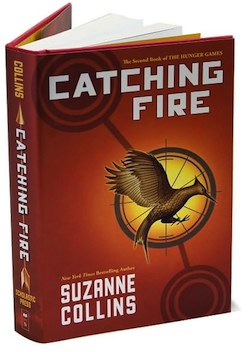The momentum that Catching Fire, sequel to The Hunger Games, manages to maintain is staggering in wake of the breakneck pace of its predecessor. In fact, I recall giving myself a few months before picking up the second book because I wanted to see how easily it drew me back in.
I read the book in two days. Not two leisure days, mind you. Needless to say, I didn’t put up much of a fight when reentering that world.
The proper introduction of President Snow at the start of the book sets the tone immediately; a permeating sense of dread that never leaves the novel, a reminder that something massive is shifting in the undercurrent, something that our heroine couldn’t begin to puzzle out. You cannot blame Katniss for her short-sightedness in Catching Fire—she’s too busy concerning herself with the fight at home, a fight to defend her family, to keep Peeta and Gale safe by turns, to stop Haymitch from drinking himself to death again.
The Victor’s Tour serves not only to tie up the loose ends left by the deaths of children in the previous Game, but also to expand Collins’ world. Getting the opportunity to feel out the districts, even to learn more about District 12 itself, is a clever way of giving us insight into Panem without a gratuitous infodump. Without Katniss struggling to feed her family, it is much easier to get a full glimpse of life in District 12, to understand exactly what those people suffer on a day to day basis.
The odd family that Katniss, Haymitch, and Peeta form is one of the most genuine aspects of the book. Three people united because they are true survivors who are (still, in Haymitch’s case) in the throes of survivor’s guilt. That guilt is what builds much of Katniss’ character for the final chapter, what makes her the perfect candidate to become the Mockingjay. Catching Fire also is the book where we begin to realize how unreliable Katniss is as a narrator, not because it’s likely that she’s telling lies, but because she misinterprets the attitudes and moods of people around her so often.
The true dilemma of the love triangle becomes clear in Catching Fire as well. We learn of Katniss’ jealousy at the thought that another girl could hold Gale’s favor, see her rescue him from a beating that could have cost him his life. Then we see her lie in bed with Peeta when nightmares wake her each night, watch her panic at the thought of losing him in the arena. It’s not that Katniss isn’t sure who she actually loves; what she fails to understand is that she loves them both. This is the conflict that builds to the resolution we find in Mockingjay.
There is an engaging balance in the movement of the book: home, then traveling, then home again, and back to the Capitol. The reader is never left in one place for too long. There’s the familiarity with something abhorred—the Capitol and all its citizens—followed abruptly by the hurt of Cinna’s death, a warning slap for getting too comfortable with such ostentatious surroundings. All the gilt and glamour doesn’t keep you any safer than Katniss.
The repeated outer trappings are what bring this book under scrutiny. At first glance, the narrative choice to end the second book in another Games seems lazy, but new themes and different relationships offer a fresh look at the format, and more importantly, make Katniss a veteran in a war she has yet to fight. The experience is necessary for her, and the new friends that she makes are invaluable. Finnick and Beetee are excellent additions to Hunger Games universe, and they are presented to us on a perfect sort of middle ground: the Quarter Quell toes the line between a regular Hunger Games and a genuine war zone, playing at both but refusing to become either.
It’s a bit cleverer than the other two books too, isn’t it? The concept of the clock arena all by itself is dead impressive, the thought that the Hunger Games themselves could be more carefully conceived than the giant field of horrors from the first novel. More importantly, we are presented with the idea that the Game itself can be outsmarted if you’re looking at it carefully enough—which is vital to the final book. It requires active thought, attention to detail. How else are you going to follow Beetee’s escape plan?
In addition, the choice to repeat certain aspects of the previous book allow for a little more play on Collins’ part, a relief in light of what’s to come. Catching Fire has more moments of unmitigated joy and tenderness in it than the other two, a wonderful reverse of standard trilogy formatting that allows this book to feel more like a breather, a moment of calm before unleashing chaos. It is much needed, the place where Collins allows the characters to grow and solidify. The joking rapport that Katniss and Finnick develop, the teasing at Peeta’s expense, the moments where the group bonds in a situation where they are expected to kill one another, it broadens the spectrum that defiance operates under; sometimes all it takes to be defiant is a little laughter.
The cliffhanger is far worse than The Hunger Games, but you had to see it coming. It’s overall place in the narrative makes it a book that is worth going back over again, especially once you have completed the trilogy. Recalling where so many of the core relationships took off their training wheels, seeing the vague outline of that storm on the horizon, all of it molds Catching Fire into one heck of a second act.
Emmet Asher-Perrin is just glad Catching Fire didn’t end with President Snow admitting that he was Katniss’ father. You can bug her on Twitter and read more of her work here and elsewhere.










